Exploring brandstory, legacy and fragrance in a venerable enterprise of 700 years.
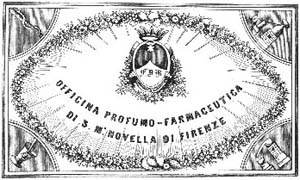
I have been exploring Santa Maria Novella for about 10 years now. And largely the opening of my exposure has been Jon Bresler — and his group in NYC, Lafco. The opening captivation was the basic scent of SMN — a peculiarly herbal incantation, nourished with spices and a kind of flowery substrate. Who else, please?
Basenotes‘ reviewers offer sentiments like these:
“wonderful. It’s aromatic and spiced, quite medicial at the opening, but very sweet and smart : a classic fragrance.”
“you must give this scent TIME. It changes throughout the day and becomes less like potpourri and more like incense mixed with some spice. It really is like stepping back in time. I have had numerous compliments while wearing this fragrance. At first it does not smell like anything except potpourii. You must let it dry down before judging this. This fragrance is timeless and I can FEEL the history when wearing this.. it’s quite upscale, well-made, and really does in fact change, like a fine wine, throughout the day.”
“Very old fashioned stuff, so don’t go in looking for aldehydes and synthetic musks and sparkling floral notes. This is earthy, dark, spicy, astringent stuff — VERY old school. Wonderfully unisex find for lovers of true “old spice.”
“Another bizarre offering from SMN. It starts off as an unbearable mess of bitter, caustic herbs and fruits. Like Marescialla it is almost a weapon in its potency. As it dries, it softens considerably, and while not unpleasant, doesn’t strike me as a skin scent so much as it seems a house scent. I would much rather burn this in a candle or spray it in a room than wear it on my skin. It smells like…potpourri. Dried, almost fermented fruits, and sharp, pungent spices (is this the mace…again!?!). Not bad, but just doesn’t make sense. Maybe it’s just too dated to be pulled off nowadays.”
“A little spooky. This is totally different from anything I have ever worn. It is challenging, and transformational in regard to first impressions and what one ultimate experiences. I am sure will be loved by some, hated by many. To me it is olfactory nirvana.” [above quotes as per http://www.basenotes.net/ID26121811.html]
There are some interesting “notes” here. Old fashioned, dated, old school, old spice. But that’s really part of the point. That is — this is a brand that’s gathered its founding in the 13th century – so rather than the typical character of a brand that is formulated on “modern” principles of scent development, this one leans to its heritage as a farmaceutica, that is — derived from an ethos of healing, herbal solutions and ingredients culled specifically from nature. “Medicinal” is a phrasing that appears in the selfsame reviews of the scent. This, and others in the framing of literature that comment on the SMN fragrance arrays.
But, after time, for me, there was more to explore — to dig in. And in traveling with a friend and colleague, client and occasional wandering buddy, Art Herstol, Global Design P&G Design Director, we’d traveled to Firenze — running daily on the train north to Cosmoprof in Bologna, Italia, seeing what’s new on the packaging front. P&G always has a big booth there, celebrating what they’ve been working on and their literal ownership of the global beauty market. During one of these trips, I’d taken Art there — finally, for me — since I’d studied the brand but never actually made it to the famed founding shop of SMN.
The founding of this multiple century enterprise begins here:
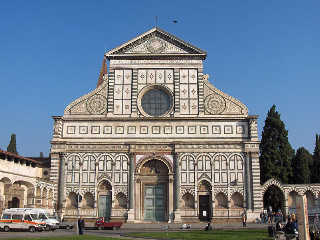
The edifice, Santa Maria Novella, is a church situated just across the main railway station which shares its name. Chronologically, it is the first great basilica in Firenze — and is the city’s principal Dominican church.
As described by Wikipedia:
“the church, the adjoining cloister, and chapterhouse contain a store of art treasures and funerary monuments. Especially famous are frescoes by masters of Gothic and early Renaissance. They were financed through the generosity of the most important Florentine families, who ensured themselves of funerary chapels on consecrated ground.” Called Novella (new), it was built on the site of the 9th-century oratory of Santa Maria delle Vigne. The site was assigned to Dominican Order in 1221, they decided to build a new church and an adjoining cloister. The church architectural design was created by two Dominican friars, Fra Sisto Fiorentino and Fra Ristoro da Campi. — and building began in the mid-13th century, developing the monastery complex of Santa Maria Novella, starting work around about 1245.(about 1246), finishing aournd 1360. The church was consecrated in 1420.
With a formal commission, Giovanni di Paolo Rucellai, a local textile merchant, Leone Battista Alberti designed the upper part of the inlaid black and white marble facade of the church (1456-1470). Already recognized as the architect of the Tempio Malatestiano in Rimini, he was also recognized for his design treatise on architecture, De Re Aedificatoria, based on the book De Architectura of the classical principles of Roman architectural theorist, Vitruvius.”
I was talking about this facade, shown above, with my partner, Dawn Clark, AIA — about the sheer graphical character of the masonry. Digging in, I learned more about that structuring — the Alberti design was based on the principled ideals of humanist architecture, proportion and classically-inspired detailing, to bear on the design while also creating harmony with the already existing medieval part of the facade. His contribution, as an added detail, consists of a broadly rendered frieze detailed with squares and everything above it, including the four white-green pilasters and a round window, crowned by a pediment with the Dominican solar emblem, and flanked on both sides by enormous S-curved volutes.
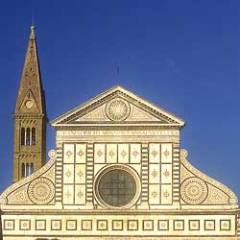
That answers that query about the design detailing — where, how and for what reasoning. There’s another interesting detail — from the interiors: The pulpit, commissioned by the Rucellai family in 1443, was designed by Filippo Brunelleschi and executed by his adopted child Andrea Calvalcanti. This pulpit has a particular added historical significance, because from this pulpit the first attack came on Galileo Galilei, leading eventually to his indictment.
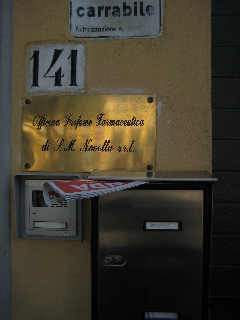
Aside from visiting their store, just round the corner from the foundation and monastery, I had the chance to explore their recently created factory somewhere outside Firenze.
More history:
Therein lies the foundation of the key Dominican expression in Firenze — and the beginnings of the Farmaceutica. While the origin of the Antica Farmacia goes back to the originating Dominican friars who, in 1221, settled in Florence but it was officially founded in 1612 following a suggestion made by the Granduca di Toscana. The founding director and creator of the success of the Aromateria and its products was Fra’ Angiolo Marchissi, to whom the Granduca granted the right to use the name of Fonderia di Sua Altezza Reale.
Alkermes Liquor, from a Renaissance formulation:
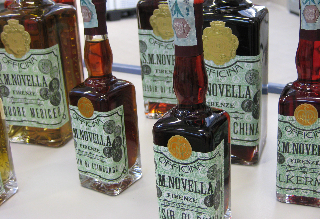
During the eighteenth century, thanks also to the extraordinary success of the many formulas created by the chemist-friars, the renown of the Farmacia crossed many borders and exports even reached the Indies and distant China.
Flask for fermentation and storage:
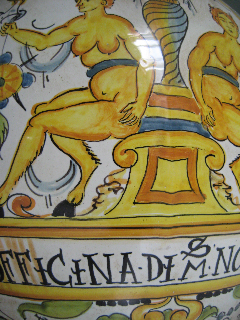
There has been continuing expansion, even with production solely in Firenze, other sales points have been opened in Roma, Milano, Forte dei Marmi, Lucca, Rimini, well as in London and Paris — and, in North America, Lafco’s outlets, under the passionately enthusiastic presence of Jon Bresler.
Ceramic flasks for fragrance oils:
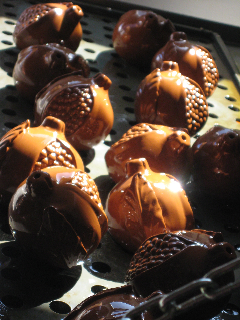
Many of the Officina’s preparations have had profound, even historical impact, epoch-making in a way: the essences, as well as the perfumes, are still prepared to a large extent following the formulas studied in 1500 for Caterina de’ Medici — all of them made by hand. The very essence that Caterina de’ Medici, Queen of France, took with her to Paris, where it acquired the name of Eau de la Reine.
The current versioning of a formulation from the 1500s:
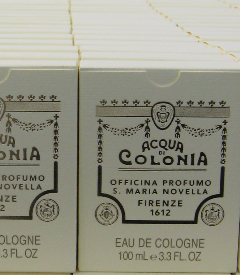
Later, the Italian Giovanni Paolo Feminis, who moved to Cologne in 1725 and began to make it there, changed its name to Acqua di Colonia, as a tribute to the city where it was produced.
The SMN monogrammatic device:
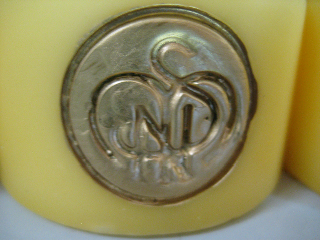
Production remains the same — careful, hand made, precise in their admixture. Aside from scents, there are other preparations still produced following the old formulary of the Dominican friars, ranging from waters, calming liquids.
Beverage additive:
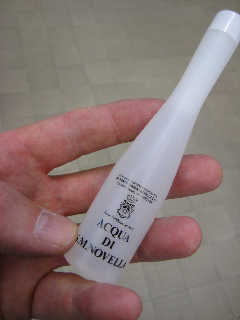
— Aromatic Vinegar or Aceto dei Sette Ladri, very useful in the case of fainting-spells, whose formula dates back to 1600. Acqua Antisterica, today known as Acqua di Santa Maria Novella, created a sedative and antispasmodic effect and was originated by Fra’ Angiolo Marchissi in 1614. The Acqua di Rose, a tonic for red eyes, was available for sale in the second half of the fourteenth century.
Licorice based liquor:
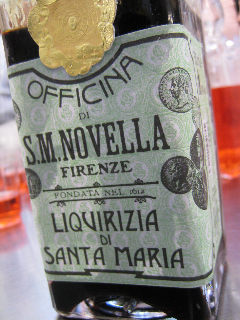
Perhaps the most famous liqueur is Alkermes which held the sales record in the nineteenth century; also held in high regard are Elixir di China and Liquore Mediceo which was named in honour of the Medici family and the Elisir di Edimburgo, an exquisite bitter.
Soap arrays:
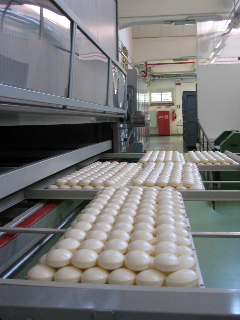
Soaps, hand-moulded one by one, aged for sixty days in ventilated cabinets and hand-wrapped are still produced with the machinery of the nineteenth century. Other items in the extensive collection include the perfumed powders produced from the ground rhizome of the iris, http://blog.girvin.com/?p=1413, the flower that grows freely on the hills around Florence in such profusion as to be adopted as the lily symbol of the city, still represented in its coat of arms.
The Officina di Santa Maria Novella is once again returning to, and reclaiming its values as a herbalist’s shop. When the Dominican friars’ ancient formulas, no longer in use, were catalogued, a period of careful study revealed their inventive qualities and, in addition, the possibility to reproduce them yet again. Invention continues. The Antica Farmacia has continued to advance product lines with other exclusive products based on medicinal plants and herbs cultivated with natural methods, sans pesticides, thus offering their emerging clientele a continuous expansion of offerings, all singularly healthful.
The production facility outside Firenze:
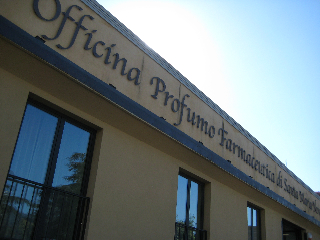
I spent some time, as well, returning to their shop just around the corner from the courtyard of the Santa Maria Novella chapel. More, to history, wonder, beauty, brand — here:
SMN | point of purchase display:
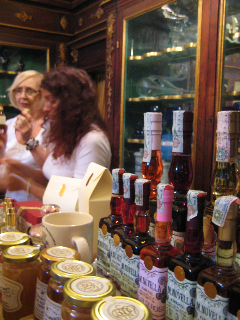
Ceiling stucco applique:
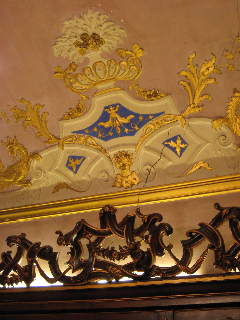
The official seal of the Dominican Order:
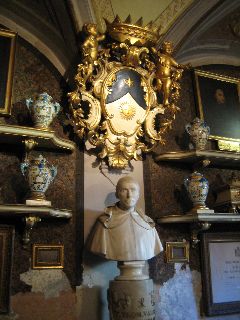
Founding Monk & Chemist: Friar Tommaso Silvio:
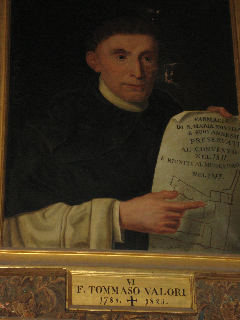
The luminous interior of SMN retail | Firenze:
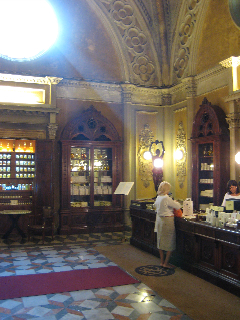
Fresco painting detail, SMN chapel:
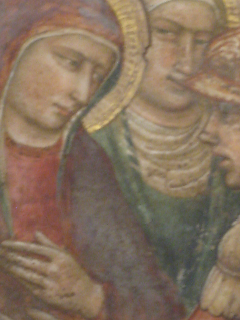
Advisement of SMN foundation:
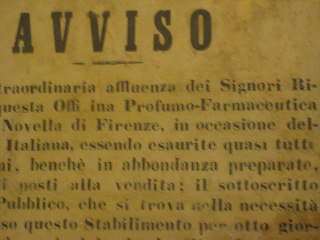
SMN workshops and manufactory:
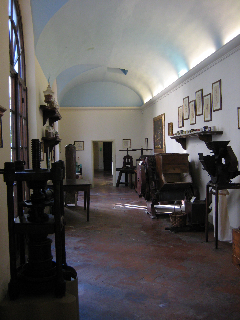
Original hand drawn studies for labeling treatments:
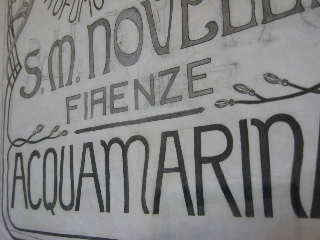
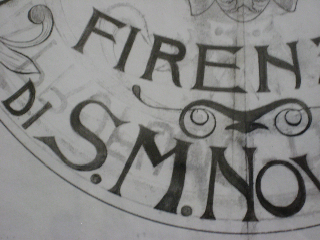
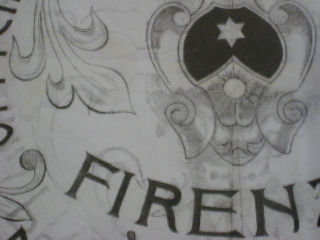
A cabinet of curiosities — product displays:
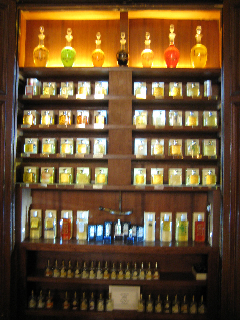
Flasks of infusions:
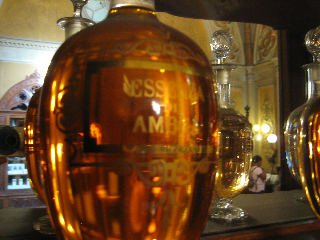
In a way, this lit heavenly star — shot in the early evening in Firenze, below — hovering above the obelisk in the square of Santa Maria Novella, relates to the character of what I’m exploring — it is about history rekindled: a story recalled, a passage — in many passages of moments — that keep coming back, like an exquisite scent, just on the edge of the breeze, jumping once again into the heart of memory.
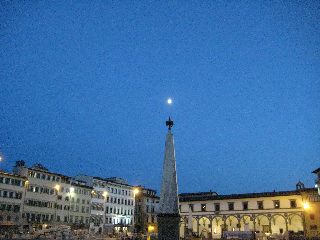
Unforgettable.
tsg | firenze
–
word note: alembic
The alembic is a kind of still that has been used since ancient times and continues to be used even today in the production of cognac, a distinctive brandy distilled from white wine in western France. In ancient times, this apparatus was called “al-anbīq,” a word that means “the still” in Arabic and can be traced to “ambix,” meaning “still” in Greek. When the apparatus found its way into Medieval European laboratories, scientific texts first transformed the Arabic word into Medieval Latin as “alembicum.” English speakers shortened it to “alembic,” and some also dropped the initial “a.” That change led to “limbeck,” a standard variant still in use today. “Alembic” acquired its figurative use in the 17th century.
Stacked flask alembics from Santa Maria Novella:
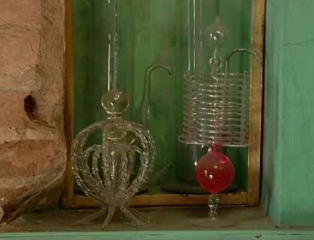
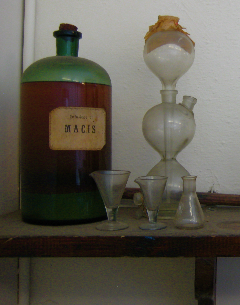
Long stemmed alembics from another old farmacia off the square, Il Duomo, Firenze:
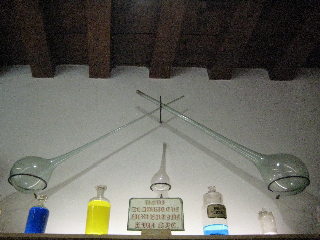
The current directorial leadership of SMN: Eugenio Alphandery
